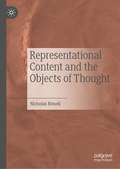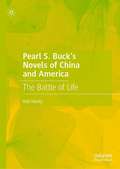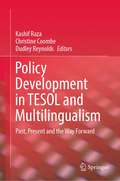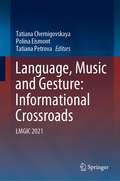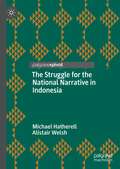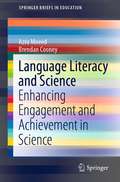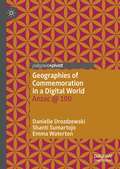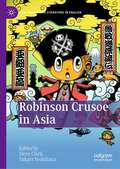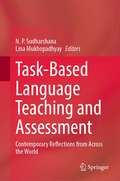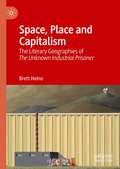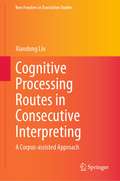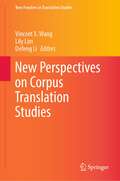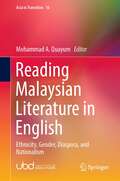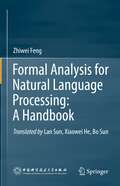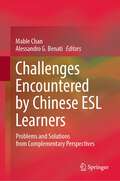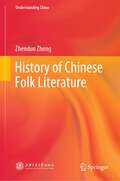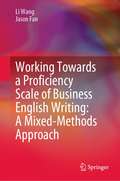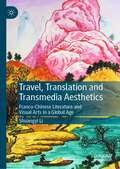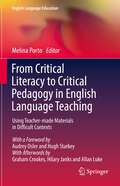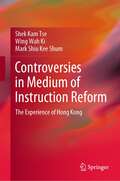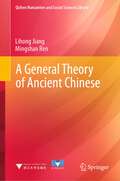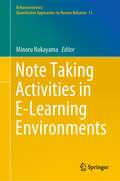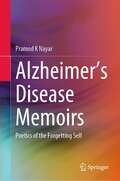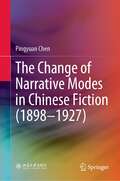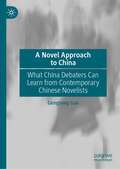- Table View
- List View
Representational Content and the Objects of Thought
by Nicholas RimellThis book defends a novel view of mental representation—of how, as thinkers, we represent the world as being. The book serves as a response to two problems in the philosophy of mind. One is the problem of first-personal, or egocentric, belief: how can we have truly first personal beliefs—beliefs in which we think about ourselves as ourselves—given that beliefs are supposed to be attitudes towards propositions and that propositions are supposed to have their truth values independent of a perspective? The other problem is how we can think about nonexistents (e.g., Santa Claus) given the widespread view that thought essentially involves a relation between a thinker and whatever is being thought about. The standard responses to this puzzle are either to deny that thought is essentially relational or to insist that it is possible to stand in relations to nonexistents. This book offers an error theory to the problem. The responses from this book arise from the same commitment: a commitment to treating talk of propositions—as the things towards which our beliefs are attitudes—as talk of entities that actually exist and that play a constitutive and explanatory role in the activity of thought.
Pearl S. Buck’s Novels of China and America: The Battle of Life
by Rob HardyThis book, the first single-authored book-length study of Buck’s fiction for over twenty years, shows how Buck’s thought developed through the medium of her fiction - from her early turbulent years in China to her last lonely days in the United States, with chapters examining her loss of faith in Christianity, her reflections on Chinese life during and after the breakdown of Old China, her voluminous reading, her confrontation with the horrors of American racism and sexism after her return to the United States, and her final metaphorical search for home as she approached death. The book argues that Buck, the first American woman to win both the Pulitzer and Nobel prizes for literature, was a heroic forerunner of those who, while occupying a place in the world, never feel fully at home there; in Buck’s case because her Chinese identity throughout her life struggled with her American. For this reason Pearl S. Buck’s fiction deserves to be considered alongside that of writers such as Anchee Min, Maxine Hong Kingston and Amy Tan. The book’s central claim is that Buck is a major novelist, capable of speaking to the distress of our times, richly deserving the honor she has received in China, and deserving greater recognition in the United States.
Policy Development in TESOL and Multilingualism: Past, Present and the Way Forward
by Christine Coombe Kashif Raza Dudley ReynoldsThe book is of interest to scholars of multilingualism, language teachers, researchers, and administrators who are developing policies on teaching English and promoting multilingualism. Given its scope, this edited collection provides an overview of how multilingualism is transforming the practice of Teaching English to Speakers of Other Languages (TESOL) in diverse contexts around the world. It serves as a platform for discussions related to policy enactment where TESOL and multilingualism are viewed as collaborative endeavours and approaches the topic from three different angles. The first section of the book provides critical examinations of previous initiatives and accomplishments in the area of language policy development and implementation. The second section describes current projects and initiatives intended to expand and strengthen the field of TESOL while providing space for local and indigenous languages to develop. The third and last part of the book highlights policy development areas that need special consideration in order to develop a form of TESOL that builds on and contributes to multilingualism.
Language, Music and Gesture: LMGIC 2021
by Tatiana Chernigovskaya Polina Eismont Tatiana PetrovaThis book brings together selected revised papers representing a multidisciplinary approach to language, music, and gesture, as well as their interaction. Among the number of multidisciplinary and comparative studies of the structure and organization of language and music, the presented book broadens the scope with the inclusion of gesture problems in the analyzed spectrum. A unique feature of the presented collection is that the papers, compiled in one volume, allow readers to see similarities and differences in gesture as an element of non-verbal communication and gesture as the main element of dance. In addition to enhancing the analysis, the data on the perception and comprehension of speech, music, and dance in regard to both their functioning in a natural situation and their reflection in various forms of performing arts makes this collection extremely useful for those who are interested in human cognitive abilities and performing skills. The book begins with a philosophical overview of recent neurophysiological studies reflecting the complexity of higher cognitive functions, which references the idea of the baroque style in art being neither linear nor stable. The following papers are allocated into 5 sections. The papers of the section “Language-Music-Gesture As Semiotic Systems” discuss the issues of symbolic and semiotic aspects of language, music, and gesture, including from the perspective of their notation. This is followed by the issues of "Language-Music-Gesture Onstage" and interaction within the idea of the "World as a Text." The papers of “Teaching Language and Music” present new teaching methods that take into account the interaction of all the cognitive systems examined. The papers of the last two sections focus on issues related primarily to language: The section "Verbalization Of Music And Gesture" considers the problem of describing musical text and non-verbal behavior with language, and papers in the final section "Emotions In Linguistics And Ai-Communication Systems” analyze the ways of expressing emotions in speech and the problems of organizing emotional communication with computer agents.
The Struggle for the National Narrative in Indonesia
by Michael Hatherell Alistair WelshThis book offers a unique analysis of how political representatives construct ideas about the nation in contemporary Indonesian politics. In their struggle to define what the authors call the ‘national narrative’, would-be national leaders seek to develop a story about the nation’s past, present and future. These stories feature a unique plot, set of characters, and a moral that the political narrator hopes will resonate. In contemporary Indonesia, the authors assess two prominent national narratives: the technocratic and populist national narratives. The book concludes with an analysis that considers other potential sources of ideas about the nation, as well as the potential implications for domestic politics and Indonesian grand strategy.
Language Literacy and Science: Enhancing Engagement and Achievement in Science (SpringerBriefs in Education)
by Azra Moeed Brendan CooneyThis book presents the findings of two case studies in the 'Making Connections' two-year project funded by the New Zealand Ministry of Education. It shows how science literacy was improved in a state coeducational school with Pacific Island students from diverse linguistic backgrounds. This book details ideas and strategies relevant to schools where English literacy has an impact on the science engagement and achievement of ethnically diverse student populations. It also presents the teaching as inquiry model and its usage by teachers to improve aspects of their teaching strategies.
Geographies of Commemoration in a Digital World: Anzac @ 100
by Danielle Drozdzewski Shanti Sumartojo Emma WatertonThis book reframes commemoration through distinctly geographical lenses, locating it within experiential and digital worlds. It interrogates the role of power in representations of memory and shows how experiences of commemoration sit within, alongside and in contrast to its official normative forms. The book charts how memories, places and experiences of commemoration play out and have, or have not, changed in and through a digital world. Key to the book’s exploration is a new epistemology of memory, underpinned by an embodied research approach.
Robinson Crusoe in Asia (Asia-Pacific and Literature in English)
by Steve Clark Yukari YoshiharaThis collection of essays expands the study of that immensely widely read and much-adapted novel, beyond the first book – The Life and Strange Surprising Adventures of Robinson Crusoe (usually known simply as Robinson Crusoe) – to take in the far less well-known Farther Adventures and the almost unread Serious Reflections, beyond Defoe’s texts, to their re-writing and adaptation and beyond the Atlantic and South American context to an Asian and Pacific context. The essays consider both how Asia is represented in the books (in terms of politics, economics, religion), and how the book has been received, adapted, and taught, particularly in Asian contexts.
Task-Based Language Teaching and Assessment: Contemporary Reflections from Across the World
by N. P. Sudharshana Lina MukhopadhyayThis book provides interdisciplinary perspectives on task-based language teaching (TBLT) and task-based language assessment (TBLA) in English as a second language (ESL) context. It discusses theoretical and experimental insights of TBLT and TBLA from cognitive, cognitive linguistic, and psycholinguistic viewpoints. The chapters, written by leading language teaching specialists in the field, introduce the reader to a comprehensive range of issues related to TBLT and TBLA such as curriculum design, materials development, and classroom teaching & testing. With interdisciplinary appeal, the book is a valuable resource for researchers in task-based language teaching and assessment. It is equally useful for teachers to whom it offers practical suggestions for designing tasks for teaching and testing.
Space, Place and Capitalism: The Literary Geographies of The Unknown Industrial Prisoner
by Brett HeinoThis book is an original contribution to literary geography and commentaries on the work of David Ireland. It plots the relationship between the spaces and places of 1970s Australian capitalism as it evolves through Ireland’s 1971 Miles Franklin prize-winning novel The Unknown Industrial Prisoner. In particular, the book theorises the relationship between space and place in literature through two highly innovative arguments: a focus on the spatial unconscious as a means to assess and track the spatiality of capitalism in the novel form; and the articulation of a regime of space through the perceived, conceived and lived constitution of space. Drawing together concepts from radical geography and structural Marxist literary theory, it explores the dominance of the regime of abstract space in the Australian context. The text also examines the nature and possibilities of place-based strategies of resistance, and concludes by suggesting opportunities for future research and plotting the ways in which The Unknown Industrial Prisoner continues to speak to contemporary Australia.
Cognitive Processing Routes in Consecutive Interpreting: A Corpus-assisted Approach (New Frontiers in Translation Studies)
by Xiaodong LiuThis book addresses a controversial issue regarding SL-TL transfer in the translation process, namely the question as to the dominant route in English-Chinese and Chinese-English professional consecutive interpretations, respectively: the form-based processing route or meaning-based processing route. It presents a corpus-assisted product study, in which the interpreting processing patterns of culture-specific items (CSIs) are analyzed. The study reveals that the dominant route in English vs. Chinese consecutive interpreting varies under different circumstances. Four factors are proposed to account for such differences: linguistic variables (e.g., grammatical complexity of the unit), type of CSI, language direction, and extra-linguistic variables (e.g., multilateral or bilateral settings). In summary, the book systematically introduces a corpus-assisted approach to translation process research, which will benefit all readers who are interested in translation process research but cannot employ neuroscientific measures.
New Perspectives on Corpus Translation Studies (New Frontiers in Translation Studies)
by Defeng Li Lily Lim Vincent X. WangThe book features recent attempts to construct corpora for specific purposes – e.g. multifactorial Dutch (parallel), Geasy Easy Language Corpus (intralingual), HK LegCo interpreting corpus – and showcases sophisticated and innovative corpus analysis methods. It proposes new approaches to address classical themes – i.e. translation pedagogy, translation norms and equivalence, principles of translation – and brings interdisciplinary perspectives – e.g. contrastive linguistics, cognition and metaphor studies – to cast new light. It is a timely reference for the researchers as well as postgraduate students who are interested in the applications of corpus technology to solving translation and interpreting problems.
Reading Malaysian Literature in English: Ethnicity, Gender, Diaspora, and Nationalism (Asia in Transition #16)
by Mohammad A. QuayumThis book brings together fourteen articles by prominent critics of Malaysian Anglophone literature from five different countries: Australia, Italy, Malaysia, Singapore, and the US. It investigates the thematic and stylistic trends in the literary products of selected writers of the tradition in the genres of drama, fiction, and poetry, from its beginnings to the present, focusing mainly on the postcolonial themes of ethnicity, gender, diaspora, and nationalism, which are central to the creativity and imagination of these writers. The book explores the works of not just the established writers of the tradition but also those who have received little critical attention to date but who are equally gifted, such as Adibah Amin, Edward Dorall, Rehaman Rashid, and Huzir Suleiman. The chapters collectively address the challenges and achievements of writers in the English language in a country where English is widely used in daily life and yet marginalised in the creative domain to elevate the status of writings in the national language, i.e., Bahasa Malaysia. The book will demonstrate that in spite of such recurrent neglect of the medium, Malaysia has produced a number of outstanding writers in the language, who are comparable in creativity and craftsmanship to writers of other Anglophone traditions. The book will be of interest to readers and researchers of Malaysian literature, postcolonial literatures, minority literatures, gender studies, and Southeast Asian studies.
Formal Analysis for Natural Language Processing: A Handbook
by Zhiwei FengThe field of natural language processing (NLP) is one of the most important and useful application areas of artificial intelligence. NLP is now rapidly evolving, as new methods and toolsets converge with an ever-expanding wealth of available data. This state-of-the-art handbook addresses all aspects of formal analysis for natural language processing. Following a review of the field’s history, it systematically introduces readers to the rule-based model, statistical model, neural network model, and pre-training model in natural language processing. At a time characterized by the steady and vigorous growth of natural language processing, this handbook provides a highly accessible introduction and much-needed reference guide to both the theory and method of NLP. It can be used for individual study, as the textbook for courses on natural language processing or computational linguistics, or as a supplement to courses on artificial intelligence, and offers a valuable asset for researchers, practitioners, lecturers, graduate and undergraduate students alike.
Challenges Encountered by Chinese ESL Learners: Problems and Solutions from Complementary Perspectives
by Mable Chan Alessandro G. BenatiThis book provides a blended approach in outlining the properties of grammatical knowledge that have been causing difficulty to Chinese speaking learners, including tense and aspect, articles, passives, unaccusatives, plurality and motion verbs. It explains from different linguistics perspectives how these constraints/difficulties might be dealt with. It also offers readers a comprehensive account of these problems, and outlines the possible pedagogical solutions teachers can try in the classroom. These topics are selected because they bring substantial challenges and difficulties to Chinese English as a Second Language (ESL) learners. This book bridges the gap between acquisition theory and language pedagogy research, benefiting not just language learners but language teachers around the world, and all those who would like to witness collaboration between second language acquisition theory and second language teaching practice in general. It initiates future work in which researchers from different fields with diverging theoretical perspectives and methodological approaches will be able to develop studies that are compatible with each other. This overall can facilitate our understanding of second language acquisition, and how instruction might help.
History of Chinese Folk Literature (Understanding China)
by Zhenduo ZhengThis book mainly addresses the position, function, influence, and values of folk oral literature in the history of Chinese literature. Divided into 14 chapters, it systematically covers central aspects of folklore literature such as ballads, folk songs, Bianwen, Zajuci, Guzici, Zhugongdiao, Sanqu, Baojuan, Tanci, Zidishu, and so on from the Pre-Qin to the late Qing Dynasties, filling several gaps in literary history studies. It is a comprehensive literary work, and many of the materials cited here are rare and difficult to find. In addition, the book proposes some important theories, especially six highly generalized qualities of folk literature, namely that it is: popular, collective, oral, fresh, effusive, and innovative.With detailed, extensive materials, and quotations, the book represents the most systematic and comprehensive work to date on ancient Chinese folk literature. It is mutually complementary with Guowei Wang’s A Textual Research of the Traditional Chinese Opera in the Song and Yuan Dynasties and Xun Lu’s A Brief History of Chinese Fiction; all three works are regarded as the most essential classics for researching the history of Chinese literature.
Working Towards a Proficiency Scale of Business English Writing: A Mixed-Methods Approach
by Li Wang Jason FanThis book presents an empirical study to develop and validate a proficiency scale of business English writing in the Chinese tertiary context. Through a mixture of intuitive, quantitative and qualitative methods, the book demonstrates how a pool of descriptors are collectively formulated, statistically calibrated and meticulously validated for the establishment of a proficiency scale of business English writing. The writing scale differs in significant ways from the existing language scales, most of which were constructed in English as L1 or L2 contexts and applied to English for General Purposes (EGP) domains. This book also provides important insights into the construct of business English writing as well as the methods for English for Specific Purposes (ESP) proficiency scale development and validation. It is of particular interest to those who work in the area of ESP teaching and assessment.
Travel, Translation and Transmedia Aesthetics: Franco-Chinese Literature and Visual Arts in a Global Age
by Shuangyi LiThis book examines the works of four contemporary first-generation Chinese migrant writer-artists in France: François CHENG, GAO Xingjian, DAI Sijie, and SHAN Sa. They were all born in China, moved to France in their adulthood to pursue their literary and artistic ambitions, and have enjoyed the highest French and Western institutional recognitions, from the Grand Prix de la Francophonie to the Nobel Prize in Literature. They have established themselves not only as writers, but also as translators, calligraphers, painters, playwrights, and filmmakers mainly in their host country. French has become their dominant—but not only—language of literary creation (except for Gao); yet, linguistic idioms, poetic imagery, and classical thought from Chinese cultural heritage permeate their French texts and visual artworks, reflecting a strong translingual and transmedial sensibility. The book provides not only distinctive literary and artistic examples beyond existing studies of intercultural encounter, French postcolonial, and Chinese diasporic enquiries; more importantly, it formulates a theoretical model that captures the creative dynamics between the French/francophone and Chinese/sinophone spaces of articulation, thereby contributing to contemporary debates about literary and artistic production, interpretation, and circulation in the global development of comparative/world literature, as well as intermediality studies.
From Critical Literacy to Critical Pedagogy in English Language Teaching: Using Teacher-made Materials in Difficult Contexts (English Language Education #23)
by Melina PortoWith a Foreword by Hugh Starkey and Audrey Osler, and Afterwords by Graham Crookes, Hilary Janks and Allan Luke, this book promotes critical language education and illustrates how a critical agenda can be enacted in English language education in real classrooms. It presents four cases located in primary and secondary schools in the province of Buenos Aires in Argentina in contexts that can be characterised as vulnerable or difficult. It describes the possibilities, challenges and limitations of this critical agenda using students’ drawings, posters, leaflets, artwork, classroom activities and conversational data as foundation, and including the voices of local teachers in their classrooms. Importantly, these teachers used teacher-made, locally produced, critical post-method materials, described by the author of those materials in one of the chapters. In this way, the book offers a unique balance of researcher, teacher and materials writer voices. These materials are included in the book and can help language teachers around the world to introduce critical perspectives in their specific contexts. The book is appealing to researchers, classroom teachers, teacher educators, and materials writers and developers interested in critical language education.
Controversies in Medium of Instruction Reform: The Experience of Hong Kong
by Shek Kam Tse Wing Wah Ki Mark Shiu ShumThe book is an in-depth and comprehensive analysis of the case of language in education reform and language policy controversies of Hong Kong over the initial two decades after 1997. It is a scholarly monograph of conscientious educators and researchers who have been active during the education reform, collaborating with different parties on school development and classroom teaching experiments. This book provides a multiple-perspective investigation into the education and language matters. Besides socio-political perspectives, this book also emphasizes the frontline educational and practical perspectives. The book explores the benefits and effective methods of mother-tongue and multi-lingual teaching that have emerged in the period. Based on the problematic experience of language purism and bifurcation in the reform, the book argues for an inclusive multilingual education policy with mother-tongue as the core. This book provides potential solutions and good practices to tackle the complex issues brought about by medium of instruction policy reforms in post-colonial times.
A General Theory of Ancient Chinese (Qizhen Humanities and Social Sciences Library)
by Lihong Jiang Mingshan RenThis book systematically outlines the development of ancient Chinese. Consisting of 20 chapters, the self-contained work presents macro-level discussions on a broad range of topics, including: philology, phonology, exegetics, certain words’ special meanings, sentence types, the flexible use of words, different grammars in ancient and modern times, and rhetoric. Though chiefly focusing on vocabulary, the book also addresses grammar, and points out grammar problems that differ considerably from those in modern Chinese, in addition to combining morphology and syntax. Further, unlike the majority of textbooks on the subject, it pays more attention to the rhetoric used in ancient Chinese literary works. Rather than simply analyzing linguistic phenomena, the book also (and more importantly) provides a meaningful approach to the study of ancient Chinese. Accordingly, it offers a valuable asset for researchers, graduate students, and everyone else who is interested in ancient Chinese.
Note Taking Activities in E-Learning Environments (Behaviormetrics: Quantitative Approaches to Human Behavior #11)
by Minoru NakayamaThe main focus of this book is presenting practical procedures for improving learning effectiveness using note taking activities during e-learning courses. Although presentation of e-learning activities recently has been spreading to various education sectors, some practical problems have been discussed such as evaluation of learning performance and encouragement of students. The authors introduce note taking activity as a conventional learning tool in order to promote individual learning activity and learning efficacy. The effectiveness of note taking has been measured in practical teaching in a Japanese university using techniques of learning analytics, and the results are shown here. The relationships between note taking activity and students’ characteristics, the possibility of predicting the final learning performance using metrics of students’ note taking, and the effectiveness for individual emotional learning factors are evaluated. Some differences between blended learning and fully online learning courses are also discussed. The authors provide novel analytical procedures and ideas to manage e-learning courses. In particular, the assessment of note taking activity may help to track individual learning progress and to encourage learning motivation.
Alzheimer's Disease Memoirs: Poetics of the Forgetting Self
by Pramod K NayarThis book examines writings by people living with Alzheimer's Disease and their caregivers. Its focus areas include the construction of the self in the face of diminishing linguistic and cognitive abilities, the stigmatization of ageing, the various narrative strategies that these texts (often collaborative) employ, the health activism and advocacy generated via a 'biosociality,' and the ethics of care. It examines the 'disease writing' genre about a condition that ravages the ability to use language. It serves as a "literary" examination of the work done in this area through a critical reading of the memoirs of those with AD and caregivers and a healthy dose of literary theory. The book is a valuable resource for those interested in literary and critical theory and researchers in the field of ageing/dementia studies.
The Change of Narrative Modes in Chinese Fiction (1898–1927)
by Pingyuan ChenThis book examines the Chinese fictions (xiaoshuo) published between 1898 and 1927 – three pivotal decades, during which China underwent significant social changes. It applies Narratology and Sociology of the Novel methods to analyze both the texts themselves and the social-cultural factors that triggered the transformation of the narrative mode in Chinese fiction. Based on empirical data, the author argues that this transformation was not only inspired by translated Western fiction, but was also the result of a creative transformation in tradition Chinese literature.
A Novel Approach to China: What China Debaters Can Learn from Contemporary Chinese Novelists
by Gengsong GaoThis book explores Chinese novelists’ distinctive contributions to the China debate in terms of the key issues of Chinese language, power dynamics and Confucian tradition. As China is rising, Chinese scholars and policymakers are debating heatedly over China’s past, present and future. Who are the major debaters? How do they analyze China’s problems and figure out solutions? What are the main achievements and weaknesses of the Chinese intellectual debate and discourse? Chinese novelists also get involved in the China debate. However, their voices are rarely heard. This book argues that, by dramatizing the diversities of ordinary social actors’ everyday languages, active discursive practices and enchanted local traditions, Chinese novelists do not merely illustrate the dominant liberal, the New Left and the New Confucian ideologies, but enrich the China debate and provide a “novel” approach to our understanding of modern China.
